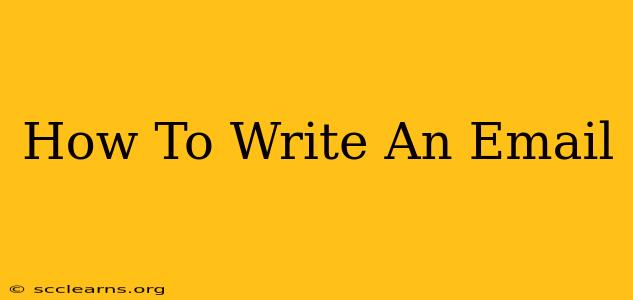Writing effective emails is a crucial skill in today's digital world. Whether you're crafting a professional message to a client, a casual note to a friend, or a formal request to your boss, understanding the nuances of email composition can significantly impact your communication success. This guide will walk you through the essential steps of writing a compelling and effective email, no matter the context.
Understanding Your Audience and Purpose
Before you even begin typing, consider who you're writing to and why. This seemingly simple step is foundational to writing an effective email.
-
Identify your audience: Are you emailing a colleague, a potential client, a family member, or a friend? Your tone, language, and level of formality should adapt to your audience. A formal email to a potential investor will differ greatly from a casual email to a friend.
-
Define your purpose: What do you want to achieve with this email? Are you requesting information, making a sale, offering support, or simply catching up? Having a clear purpose will guide your writing and ensure a focused message.
Crafting the Perfect Email Structure
A well-structured email is easy to read and understand. Here's a breakdown of the essential components:
1. Subject Line: The First Impression
Your subject line is the first (and sometimes only) thing the recipient sees. Make it count!
- Be clear and concise: Avoid ambiguity. Clearly state the email's purpose.
- Use keywords: If appropriate, include relevant keywords that will help the recipient quickly understand the email's content.
- Keep it brief: Aim for under 50 characters.
- Examples: Instead of "Update," use "Project X Update: Next Steps." Instead of "Question," use "Quick Question Regarding Invoice #1234."
2. Salutation: Setting the Tone
The salutation sets the tone for your email.
- Use a professional greeting: "Dear [Name]," is generally a safe and professional choice.
- Use a less formal greeting if appropriate: "Hi [Name]," or "Hello [Name]," are acceptable for casual emails.
- Avoid generic greetings: "To whom it may concern" should be used sparingly.
3. Body: Getting to the Point
The body of your email is where you deliver your message. Here are some key tips:
- Keep it concise: Get straight to the point and avoid unnecessary jargon or fluff.
- Use short paragraphs: Break up large blocks of text to make your email easier to read.
- Use bullet points or numbered lists: This helps organize information and improves readability.
- Proofread carefully: Errors in grammar and spelling can undermine your credibility.
4. Closing: A Polished Finish
Your closing should be polite and professional.
- Use a suitable closing: "Sincerely," "Regards," "Best regards," and "Thank you" are all common choices.
- Include your name and contact information: This allows the recipient to easily respond.
5. Signature: Professional Touch
A professional email signature adds a touch of professionalism and provides your contact information. Include:
- Your name: Full name is preferred.
- Your title: Your job title.
- Your company: The name of your company.
- Your contact information: Phone number and email address.
- Website (optional): Link to your company website.
Email Best Practices for Different Scenarios
Here are some email best practices for various scenarios:
- Professional Emails: Maintain a formal tone, use proper grammar and spelling, and proofread carefully before sending.
- Casual Emails: A more relaxed tone is acceptable, but still maintain clarity and professionalism.
- Emails to Clients: Be responsive, helpful, and professional. Address their concerns promptly and efficiently.
- Emails to Colleagues: Maintain a respectful and collaborative tone.
Avoiding Common Email Mistakes
- Avoid using all caps: It comes across as shouting.
- Don't overuse exclamation points: Use them sparingly to avoid seeming overly enthusiastic or unprofessional.
- Avoid forwarding emails unnecessarily: Only forward emails that are directly relevant to the recipient.
- Always proofread your email before sending: This prevents embarrassing errors.
By following these guidelines, you'll be well on your way to writing clear, concise, and effective emails that achieve your communication goals. Remember, effective email writing is a skill that improves with practice. The more you write, the more confident and efficient you will become.

